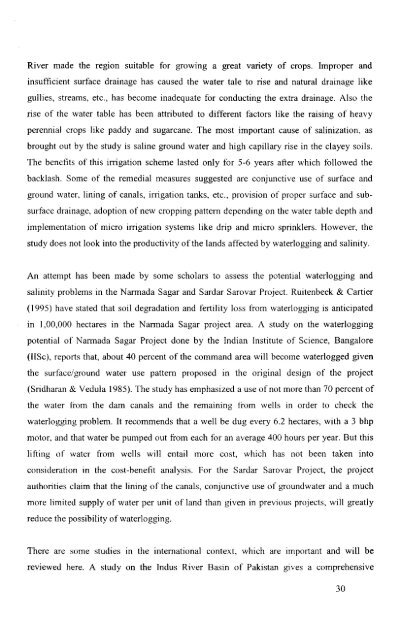Water Users Association and Irrigation Management - Institute for ...
Water Users Association and Irrigation Management - Institute for ...
Water Users Association and Irrigation Management - Institute for ...
You also want an ePaper? Increase the reach of your titles
YUMPU automatically turns print PDFs into web optimized ePapers that Google loves.
River made the regIOn suitable <strong>for</strong> growmg a great variety of crops. Improper <strong>and</strong><br />
insufficient surface drainage has caused the water tale to rise <strong>and</strong> natural drainage like<br />
gullies, streams, etc., has become inadequate <strong>for</strong> conducting the extra drainage. Also the<br />
rise of the water table has been attributed to different factors like the raising of heavy<br />
perennial crops like paddy <strong>and</strong> sugarcane. The most important cause of salinization, as<br />
brought out by the study is saline ground water <strong>and</strong> high capillary rise in the clayey soils.<br />
The benctits of this irrigation scheme lasted only <strong>for</strong> 5-6 years after which followed the<br />
backlash. Some of the remedial mcasures suggested are conjunctive use of surface <strong>and</strong><br />
ground water, lining of canals, irrigation tanks, etc., provision of proper surface <strong>and</strong> subsurface<br />
drainage, adoption of new cropping pattern depending on the water table depth <strong>and</strong><br />
implementation of micro irrigation systems like drip <strong>and</strong> micro sprinklers. However, the<br />
study does not look into the productivity of the l<strong>and</strong>s affected by waterlogging <strong>and</strong> salinity.<br />
An attempt has been made by some scholars to assess the potential waterlogging <strong>and</strong><br />
salinity problems in the Narmada Sagar <strong>and</strong> Sardar Sarovar Project. Ruitenbeek & Cartier<br />
(1995) have stated that soil degradation <strong>and</strong> fertility loss from waterlogging is anticipated<br />
in 1,00,000 hectares in the Narmada Sagar project area. A study on the waterlogging<br />
potential of Narmada Sagar Project done by the Indian <strong>Institute</strong> of Science, Bangalore<br />
(lISe), reports that, about 40 percent of the comm<strong>and</strong> area will become waterlogged given<br />
the surface/ground water use pattern proposed in the original design of the project<br />
(Sridharan & Vedula 1985). The study has emphasized a use of not more than 70 percent of<br />
the water from the dam canals <strong>and</strong> the remaining from wells in order to check the<br />
waterlogging problem. It recommends that a well be dug every 6.2 hectares, with a 3 bhp<br />
motor, <strong>and</strong> that water be pumped out from each <strong>for</strong> an average 400 hours per year. But this<br />
lifting of water from wells will entail more cost, which has not been taken into<br />
consideration in the cost-benefit analysis. For the Sardar Sarovar Project, the project<br />
authorities claim that the lining of the canals, conjunctive use of groundwater <strong>and</strong> a much<br />
more limited supply of water per unit of l<strong>and</strong> than given in previous projects, will greatly<br />
reduce the possibility of waterlogging.<br />
There are some studies in the international context, which are important <strong>and</strong> will be<br />
reviewed here. A study on the Indus River Basin of Pakistan gives a comprehensive<br />
30
















